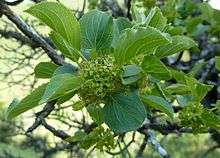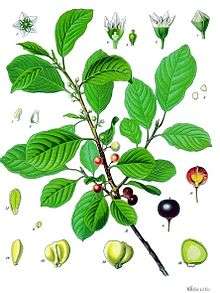Rhamnus (plant)
Rhamnus is a genus of about 110 accepted species of shrubs or small trees, commonly known as buckthorns, in the family Rhamnaceae. Its species range from 1 to 10 meters (3'-30') tall (rarely to 15 metres, 50') and are native mainly in east Asia and North America, but found throughout the temperate and subtropical Northern Hemisphere, and also more locally in the subtropical Southern Hemisphere in parts of Africa and South America. One species, the common buckthorn (Rhamnus cathartica), was able to flourish as an invasive plant in parts of Canada and the U.S.[1]
| Rhamnus | |
|---|---|
 | |
| Rhamnus cathartica | |
| Scientific classification | |
| Kingdom: | Plantae |
| Clade: | Tracheophytes |
| Clade: | Angiosperms |
| Clade: | Eudicots |
| Clade: | Rosids |
| Order: | Rosales |
| Family: | Rhamnaceae |
| Tribe: | Rhamneae |
| Genus: | Rhamnus L. |
| Species | |
|
See text | |

Both deciduous and evergreen species occur. The leaves are simple, 3 to 15 centimeters (1"- 6") long, and arranged alternately, in opposite pairs, or almost paired (subopposite). One distinctive character of many buckthorns is the way the veination curves upward towards the tip of the leaf. The plant bears fruits which are black or red berry-like drupes. The name is due to the woody spine on the end of each twig in many species. One species is known to have potential to be used medicinally.[2]
Description
Rhamnus species are shrubs or small to medium-sized trees, with deciduous or rarely evergreen foliage. For example, when it comes to the European Buckthorn, this shrub can grow to be taller than the average human height.[3] Branches are unarmed or end in a woody spine. The leaf blades are undivided and pinnately veined. Leaf margins are serrate or rarely entire. Most species have yellowish green, small, bisexual or unisexual, rarely polygamous flowers; which are produced singly or in axillary cymes, cymose racemes, or cymose panicles containing a few flowers. Calyx tube campanulate to cup-shaped, with 4 or 5 ovate-triangular sepals, which are adaxially ± distinctly keeled. Petals 4 or 5 but a few species may lack petals. The petals are shorter than the sepals. Flowers have 4 or 5 stamens which are surrounded by and equal in length the petals or are shorter. The anthers are dorsifixed. The superior ovary is free, rounded, with 2-4 chambers. Fruits are a 2-4 stoned, berrylike drupe, which is obovoid-globose or globose shaped. Seeds are obovoid or oblong-obovoid shaped, unfurrowed or abaxially or laterally margined with a long, narrow, furrow. The seeds have fleshy endosperm.[4]
Distribution
Rhamnus has a nearly cosmopolitan distribution,[5] with about 150 species which are native from temperate to tropical regions, the majority of species are from east Asia and North America, with a few species in Europe and Africa.[4]
North American species include alder-leaf buckthorn (R. alnifolia) occurring across the continent, Carolina buckthorn (R. (F.) caroliniana) in the east, cascara buckthorn (R. (F.) purshiana) in the west, and the evergreen California buckthorn or coffeeberry (R. (F.) californica) and hollyleaf buckthorn (R. crocea), also in the west. Though not native to this region, the Rhamnus cathartica can be found in North America.[6]
In South America, Rhamnus diffusus is a small shrub native to the Valdivian temperate rain forests of Chile.
Buckthorns may be confused with dogwoods, which share the curved leaf venation; indeed, "dogwood" is a local name for R. prinoides in southern Africa. The two plants are easy to distinguish by slowly pulling a leaf apart; dogwoods will exude thin, white latex strings, while buckthorns will not.
Invasive species
Common buckthorn and glossy buckthorn are considered invasive species in the United States[7] and by many local jurisdictions and state governments, including Minnesota[8] and Wisconsin.[9]
When it comes to the Common Buckthorn, it has been able to spread in Canada and the U.S. so well because of some of the qualities that these plants have.[1] For example these plants are efficient growers that do not need much sunlight and are very fertile.[1] Their seeds are hardy, as well as being able to grow and spread easily in a variety of environmental conditions.[1] Also other animals prefer to leave them alone because they are not appetizing and their fruits can make some animals sick.[1] Overall they are known to have a negative effect on the surrounding environment in which they are invasive.[1] For example, the finding of one research in the U.S. found that egg mortality for frogs went up because of a chemical that the European Buckthorn releases.[10] Other species, such as the Rhamnus alaternus also make chemicals that prevent other animals from consuming them.[2]
Classification
The genus has been divided into two subgenera, which are increasingly treated as separate genera:
- Subgenus Rhamnus: flowers with four petals, buds with bud scales, leaves opposite or alternate, branches with spines. Species include:[11]

- Rhamnus alaternus – Italian buckthorn
- Rhamnus alnifolia – alderleaf buckthorn, alder-leaved buckthorn
- Rhamnus arguta – sharp-tooth buckthorn
- Rhamnus bourgaeana (unresolved species)[12] – endemic to Mallorca
- Rhamnus cathartica – common buckthorn,[13] purging buckthorn (orth. var. R. catharticus)
- Rhamnus crenulata
- Rhamnus crocea – redberry buckthorn (subsp. crocea), hollyleaf buckthorn (subsp. pilosa)
- Rhamnus davurica – Dahurian buckthorn
- Rhamnus diffusa
- Rhamnus glandulosa
- Rhamnus globosa – Lokao buckthorn
- Rhamnus ilicifolia – hollyleaf redberry
- Rhamnus integrifolia
- Rhamnus japonica – Japanese buckthorn
- Rhamnus lanceolata – lanceleaf buckthorn
- Rhamnus libanotica – Lebanese buckthorn
- Rhamnus ludovici-salvatoris – endemic to Mallorca
- Rhamnus lycioides
- Rhamnus orbiculata – Orjen buckthorn
- Rhamnus palaestina (unresolved species)[11] – (endemic to Eastern Mediterranean)
- Rhamnus pallasii – (grows in Iran)
- Rhamnus persica – Persian buckthorn (grows in Iran)
- Rhamnus petiolaris – (endemic to Sri Lanka)
- Rhamnus pirifolia – island redberry buckthorn
- Rhamnus prinoides – shiny-leaf buckthorn
- Rhamnus pumila - dwarf buckthorn
- Rhamnus saxatilis – rock Buckthorn, Avignon buckthorn, Avignon berry (syn. R. infectoria, R. infectorius)
- Rhamnus serrata – sawleaf buckthorn
- Rhamnus smithii – Smith's buckthorn
- Rhamnus staddo – Staddo (syn. R. rhodesicus)
- Rhamnus taquetii – Jejudo buckthorn
- Rhamnus utilis – Chinese buckthorn
- Subgenus Frangula: flowers with five petals, buds without bud scales, leaves always alternate, branches without spines. Species include:
- Rhamnus betulifolia (Frangula betulifolia) – birchleaf buckthorn
- Rhamnus californica (Frangula californica) – California buckthorn, coffeeberry
- Rhamnus caroliniana (Frangula caroliniana) – Carolina buckthorn, Indian cherry (orth. var. R. carolinianus)
- Rhamnus frangula (Frangula alnus) – alder buckthorn, glossy buckthorn,[13] breaking buckthorn, black dogwood
- Rhamnus hintonii (Frangula hintonii)
- Rhamnus latifolia (Frangula azorica)
- Rhamnus purshiana (Frangula purshiana) – cascara buckthorn (orth. var. R. purshianus)
- Rhamnus rubra (Frangula rubra) – red buckthorn
Ecology
Some species are invasive outside their natural ranges. R. cathartica was introduced into the United States as a garden shrub and has become an invasive species in many areas there. It is a primary host of the soybean aphid (Aphis glycines), a pest for soybean farmers across the US. The aphids use the buckthorn as a host for the winter and then spread to nearby soybean fields in the spring.[14] Italian buckthorn (R. alaternus), an evergreen species from the Mediterranean region, has become a serious weed in some parts of New Zealand,[15] especially on Hauraki Gulf islands.
Buckthorns are used as food plants by the larvae of many Lepidoptera species.
The American species are known to be hosts for the oat fungus Puccinia coronata. In a 1930 study, both kerosene and salt were employed for eradication of R. Lanceolata and both proved to be less expensive than felling these bushes.[16]
Uses
The fruit of most species contain a yellow dye and the seeds are rich in protein. Oils from the seeds are used for making lubricating oil, printing ink, and soap.[4] Many species have been used to make dyes. R. purshianus bark and fruit yield a yellow dye and, when mixed with alum, a green dye that has been used in art.[17] R. utilis provides china green, a dye used to give a bright green color to silk and wool.[18] Another species, Avignon buckthorn (R. saxatilis) provides the yellow dye Persian berry, made from the fruit.
Some species may cause demyelinating polyneuropathies.[19]
The purging buckthorn (R. cathartica) is a widespread European native species used in the past as a purgative. It was in mid 17th-century England the only native purgative.[20] It was also known pre- Linnaeus as Spina Cervina.[21] The berries of Spina Cervina are black and contain a greenish juice, along with four seeds apiece; this serves to distinguish them from those of the black alder and dogberry, which contain only one or two apiece. Its syrup is said to be churlish.[22] Its toxicity makes this a very risky herbal medicine and it is no longer in use.[23]
R. prinoides is known as gesho in Ethiopia, where it is used to make a mead called tej.
The species Rhamnus alaternus shows some promise for medicinal use as well.[2]
See also
- Sea buckthorn or Hippophae, an unrelated genus of shrubs with a similar common name
References
- Knight, Kathleen S.; Kurylo, Jessica S.; Endress, Anton G.; Stewart, J. Ryan; Reich, Peter B. (2007-12-01). "Ecology and ecosystem impacts of common buckthorn (Rhamnus cathartica): a review". Biological Invasions. 9 (8): 925–937. doi:10.1007/s10530-007-9091-3. hdl:11299/175602. ISSN 1573-1464.
- Zeouk, Ikrame; Bekhti, Khadija (2020-03-01). "A critical overview of the traditional, phytochemical and pharmacological aspects of Rhamnus alaternus: a Mediterranean shrub". Advances in Traditional Medicine. 20 (1): 1–11. doi:10.1007/s13596-019-00388-8. ISSN 2662-4060.
- Archibold, William; Brooks, Darin; Delanoy, L. (1997). "An investigation of the invasive shrub European Buckthorn, Rhamnus cathartica L., near Saskatoon, Saskatchewan". Canadian Field Naturalist. 111 – via ResearchGate.
- "Rhamnus in Flora of China @". Efloras.org. Retrieved 2013-05-07.
- "Rhamnus in Flora of Pakistan @". Efloras.org. Retrieved 2013-05-07.
- Kurylo, J. S.; Knight, K. S.; Stewart, J. R.; Endress, A. G. (2007). "Rhamnus cathartica: Native and naturalized distribution and habitat preferences1". The Journal of the Torrey Botanical Society. 134 (3): 420–430. doi:10.3159/1095-5674(2007)134[420:RCNAND]2.0.CO;2. ISSN 1095-5674.
- "Common Buckthorn". National Invasive Species Information Center. Retrieved 9 July 2018.
- "Buckthorn". Minnesota Department of Natural Resources. Retrieved 27 May 2019.
- "Bucking a Thorny Invader" (PDF). Wisconsin Department of Natural Resources. Retrieved 27 May 2019.
- "Midwestern frogs decline, mammal populations altered by invasive plant, studies reveal". ScienceDaily. Retrieved 2020-04-20.
- "The Plant List: Rhamnus". Royal Botanic Gardens, Kew and Missouri Botanic Garden. 2013.
- "The Plant List: Rhamnus bourgaeana Gand". Royal Botanic Gardens, Kew. 2013.
- "Common Buckthorn". Ontario's Invading Species Awareness Program. Retrieved 27 May 2019.
- Box: 2207A (2012-04-03). "SDSU Department of Plant Science: Managing Soybean Aphids". Sdstate.edu. Retrieved 2013-05-07.
- Synergy International Limited <http://www.synergy.co.nz> (2006-03-23). "issg Database: Ecology of Rhamnus alaternus". Issg.org. Retrieved 2013-05-07.
- Dietz and Leach, "Methods of eradicating buckthorn (rhamnus) susceptible to crown rust (puccinia coronata) of oats" USDA Circular No. 133
- Mozingo, H. N. Shrubs of the Great Basin: A Natural History. Reno, Nevada: University of Nevada Press. 1987. 342 p. In: Habeck, R. J. 1992. Rhamnus purshiana. Fire Effects Information System. USDA, Forest Service, Rocky Mountain Research Station, Fire Sciences Laboratory.
- Brunello, F. The Art of Dyeing in the History of Mankind. AATCC. 1973. pg. 381.
- "Peripheral Neuropathy: Peripheral Nervous System and Motor Unit Disorders: Merck Manual Professional". Merckmanuals.com. Retrieved 2013-05-07.
- Phil. trans. : Number 23, beginning the third year, March 11, 1666 at p.409, p.424
- Elizabeth Blackwell, "A Curious Herbal, Containing Five Hundred Cuts Of The Most Useful Plants", p.134
- William Lewis, "An Experimental History Of The Materia Medica"
- Plants for a Future: Rhamnus cathartica
External links
| Wikimedia Commons has media related to Rhamnus. |
